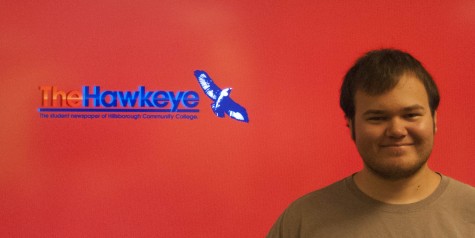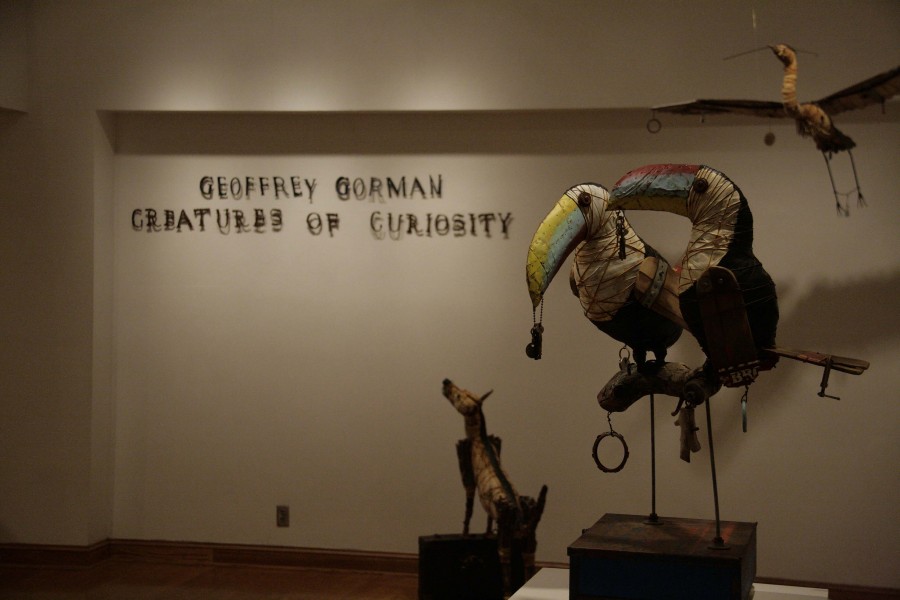Curiosity stokes the fire of creativity
For the month of March, the Ybor campus art gallery will be hosting Geoffrey Gorman’s “Creatures of Curiosity.” The Santa Fe native brings 10 years of his work to HCC for students to see how dead materials can create life in art. Wood, metal wire, and bike tires are taken apart and put together to make a facsimile of a living, breathing creature.
The materials Gorman uses are found in the woods, in barns, at Goodwill, or sent in by fans of his work. While he prefers wood and metal, he will work with almost anything. Off limits materials are parts of actual animals, including bones and feathers. Metal rings hanging from the animals are very prevalent in his work, starting when he found a string of washers in the drawers of a handyman’s workshop, “I started putting the wires with the washers on it as almost like an homage to the handyman. And then it kind of morphed into these rings and now I’ll hang just about anything off of my creatures.”
The purpose of the rings has since then become a much more natural instinct, “I’m trying to break the silhouette that you see of the animal, so there’s something else that your eye goes to. And I’m just guessing, but I think when animals meet other animals the silhouette is probably the first thing that they read, because in a life or death situation you’ve got to know very quickly who your opponent is. So these rings and things I hang off, I believe, tell the other creature what status this animal is from, what their hierarchy is.”
Gorman has recently begun using materials brought back from Alaska. A piece of his work is made from Alaskan bear’s breath mushrooms, “I just brought them back to New Mexico and let them dry, and they’re like corks now. They’re very evocative without telling you exactly what they are.” Gorman uses these mushrooms for mounting shelves and display, attributing them in one piece as clouds that a net fisher stands on.
Many of the pieces he uses have had a past life as something else. Aside from tires or washers, he brought some red cedar bark from Alaska that came from a totem pole that was being carved and made the net fisher’s head from it. Gorman’s work tends to be made from things that he feels a connection to, making his creations feel personal. A pelican with a caught fish is inspired by a previous trip to Florida Gorman explained and it has become one of his most popular pieces.
Gorman’s fondness of animals stem from his childhood on his father’s farm, “My father loved animals, so when I grew up I was surrounded by a lot of dogs and some of the other creatures we had.” Those other creatures included a red fox, a monkey, snakes, and whatever else he could find in the woods.
A favorite animal of his is the rabbit, which he describes as a trickster, “I think of rabbits as the kind of tricksters in the art world, even though in New Mexico they say that the coyote is the trickster that is, according to the Native American myths.”
Gorman titles his animal works after the scientific species name, “I could name these creatures without telling you automatically what they are. I want the viewer to be able to bring their imagination to the work.”
While his exhibit is named after an early type of pseudoscience popular in the Renaissance era, the cabinets of curiosity or “wonder rooms.” These early museums were put together by people who wanted to display interesting things they had found and tried to categorize.
The trip to the exhibit is well worth it to any sculpture fan or anyone who wants to see some amazing pieces of art. Gorman takes one man’s trash and turns it into life.

Alexander Rose is a Managing Editor of The Hawkeye.
Alex was born in Tampa, Florida. He lived in Honduras for four years then moved to Brooksville...

